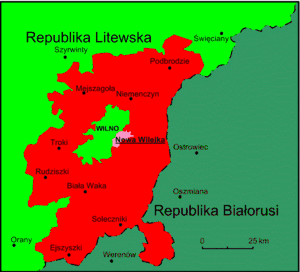Polish National-Territorial Region
The Polish National-Territorial Region (Polish: Polski Kraj Narodowo-Terytorialny) was a proposed autonomous region in Lithuania, unilaterally proclaimed by the local Polish-Lithuanian politicians on 6 September 1990. The proposed region should have included the districts of Vilnius (without the city of Vilnius), Šalčininkai and adjacent parts of some other districts — where Poles formed the majority of the population.[1] This Eastern part of Lithuania had been part of Poland during the Interwar period before being attached to Lithuania under the Mutual Assistance Treaty with the Soviet Union in 1939.The proposed capital of the region was Nowa Wilejka (Naujoji Vilnia, now part of Vilnius) which had 34% Polish population.[2] with an area of 4,930 km2 (1,900 sq mi) and population of 215,000. In the region, the Polish flag was to be used as the official flag and Rota was to be used as an anthem in the region.
| Polish National-Territorial Region Polski Kraj Narodowo-Terytorialny | |||||||||
|---|---|---|---|---|---|---|---|---|---|
| Autonomous region of the Republic of Lithuania | |||||||||
| 1990–1991 | |||||||||
 Flag | |||||||||
| Anthem | |||||||||
| Rota | |||||||||
| Capital | Naujoji Vilnia (Nowa Wilejka) | ||||||||
| Area | |||||||||
• 1990 | 4,930 km2 (1,900 sq mi) | ||||||||
| Population | |||||||||
• 1990 | 215,000 | ||||||||
| Historical era | Dissolution of the Soviet Union | ||||||||
• Self-proclaimed autonomy | 6 September 1990 | ||||||||
• Local councils suspended | 3 September 1991 | ||||||||
| |||||||||
History

After World War II, as a result of Polish population transfers, the native Polish population of Vilnius region was to a significant degree replaced with Poles from Belarus, as well as by Belarusians and Russians. This population did not have a history of strong Polish political identity. Also, a significant number of Lithuanians moved in the region. The beginnings of the autonomist movement are associated with the activities of Oleg Shenin, a member of the Central Committee of the Communist Party of the Soviet Union, aimed at the counteraction of the opposition of the republic against the Moscow rule. He is known to be instrumental in establishing similar ethnic-based subdivisions elsewhere in the collapsing Soviet Union: in Moldova and Transcaucasia.[3] At the same time, Shenin threatened Lithuania that if it would not follow the Kremlin-established mechanism of secession, Lithuania might suffer territorial losses of the areas which the Soviet Union gained in 1939 after the Soviet invasion of Poland and later transferred to the Lithuanian SSR. He also threatened to defend "certain territories from the unilateral influence of separatist forces." These threats contributed greatly to the decision of the Lithuanian powers to ban the Polish autonomy.[4]
The Polish autonomist movement (the leaders of which included Jan Ciechanowicz), who have associated with the Yedinstvo movement, had tacit support from Moscow (thus, when following the Act of the Re-Establishment of the State of Lithuania the Soviets applied a blockade against Lithuania, the areas of Eastern Lithuania with significant minority population were mostly spared of the blockade, with the aim of gaining the minority's support for Moscow). Conversely, it gained little support from Poland, since the Polish government at that time supported Lithuania's strive for independence, believing that independent Lithuania would deal with the problems of the Polish minority in a peaceful manner.
The Lithuanian government declared the formation of the so-called Polish autonomous district in Lithuania unconstitutional, and the Lithuanian parliament dissolved the elected local councils ("soviets") that had sought autonomy, on 3 September 1991.[1]
See also
- Polish minority in Lithuania
- Republic of Central Lithuania
- Vilnius Region
- Ethnic history of the Vilnius region
References
- Horne, Winston A. Van (1997). Global convulsions: race, ethnicity, and nationalism at the end of the twentieth century. SUNY Press. pp. 253–254. ISBN 0-7914-3235-1.
- Vilnius Regional Statistical Office Archived 25 March 2012 at the Wayback Machine
- Jonas Rudokas, Kas ir kodėl kūrė autonomiją Vilniaus krašte 1989–1992 m.
- Vladas Sirutavičius O polskiej autonomii narodowo-terytorialnej na Litwie (wiosna – lato 1991 roku)
Further reading
- A. Bobryk, Odrodzenie narodowe Polaków w Republice Litewskiej 1987–1997, Toruń, 2006
- Z. Kurcz, Mniejszość polska na Wileńszczyźnie. Studium socjologiczne, Wrocław, 2005.
- K. Garšva, Pietryčių Lietuvos autonomijos klausimai, Vilnius 1990
- K. Garšva, Lietuvos lenkų autonomijos kūrimo istorija, Lietuvos rytai, red. K. Garšva, L. Grumadienė, Vilnius 1993, pp. 314–320.